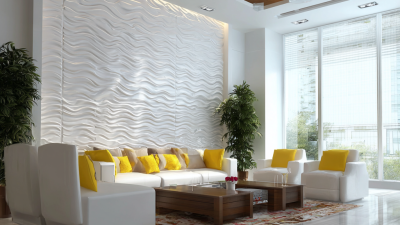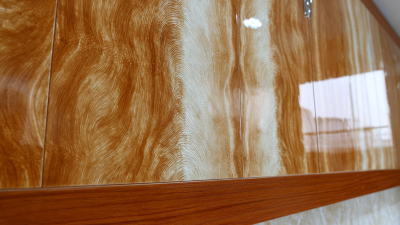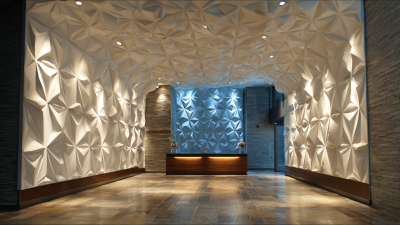
Transforming your space with Indoor Decoration Wall Panels can significantly enhance both the aesthetics and acoustic performance of your environment. These innovative panels not only serve as a stylish design element but also play a crucial role in sound management, making them an excellent choice for both residential and commercial settings.

As we delve into the world of indoor decoration, this guide will provide you with essential tips and strategies for selecting and installing wall panels that not only complement your interior design but also improve sound quality. Whether you're looking to create a cozy home theater, a serene office space, or a vibrant living room, understanding how to effectively use Indoor Decoration Wall Panels will allow you to create an inviting atmosphere that resonates with both beauty and functionality.
Let’s explore how these versatile panels can be used to transform your space into a harmonious sanctuary.
When transforming your space with indoor decoration wall panels, choosing the right material is crucial for enhancing both aesthetics and acoustic performance. Popular materials such as acoustic foam, wood panels, and fabric-covered options not only improve sound quality but also add texture and warmth to a room. A recent industry report indicates that sound-absorbing panels can reduce noise levels by up to 50%, making them a wise investment for both comfort and style.
Tips: When selecting materials, consider how they will harmonize with your existing decor. For example, pairing grey wall panels with softer tones creates a balanced and inviting atmosphere. Additionally, integrating elements like sustainable cladding not only demonstrates an eco-conscious approach but also introduces a unique visual appeal. Sustainable materials, such as bamboo or recycled wood, are trending in design, providing both aesthetic value and reducing your carbon footprint.
Incorporating these materials thoughtfully can lead to a significant transformation in your living space. Opt for panels that reflect your personal style while serving functional purposes; this duality enhances the overall experience of your home. For instance, varying textures and colors can break the monotony, creating dynamic spaces that invite relaxation and conversation.
When transforming your space with indoor decoration wall panels, color selection plays a crucial role in achieving both aesthetic appeal and functional performance. Studies show that the use of color can significantly influence mood and perception. According to the Color Marketing Group, 93% of consumers make purchasing decisions based on visual appearance, which highlights the importance of properly chosen wall panels in any interior design scheme.
Choosing the right color for your wall panels can be guided by the principles of color theory, which emphasize harmony, contrast, and balance. For example, soft neutrals like beige and light gray can create an inviting atmosphere while complementing vibrant decor pieces. On the other hand, bold colors such as deep blues or rich greens can serve as a statement, enhancing the overall character of the space. According to a report by the Paint Manufacturers Association, the right choice of color can improve a room's perceived size and light quality, as lighter shades can make a room feel more spacious and airy.
Furthermore, it's essential to consider how colors interact with sound within the space. Panel materials often have acoustic properties, and selecting colors that reflect your design vision while maintaining a suitable acoustic environment can result in a well-rounded atmosphere. Research by the Acoustical Society of America indicates that colors can alter perception of sound quality, and harmonizing color choices with the functional aspects of wall panels can enhance both aesthetic enjoyment and auditory comfort.

Acoustic solutions are essential for creating a comfortable indoor environment. Properly designed wall panels can significantly improve sound quality by reducing echo and minimizing sound transmission between spaces. According to a report by the Acoustical Society of America, poor acoustic conditions can negatively affect productivity and concentration levels, with studies showing that up to 70% of employees are distracted by noise in open office environments. By incorporating acoustic wall panels, you can enhance both aesthetics and functionality in your space.
Tips: When selecting wall panels, consider materials that have high sound absorption ratings, such as fiberglass or mineral wool. These materials not only dampen unwanted noise but also add a stylish touch to your décor.
Moreover, strategically placing the panels on walls where sound reflects the most can further boost their effectiveness. Research indicates that placing panels at first reflection points can reduce sound levels by up to 10 decibels, leading to a noticeably quieter and more serene atmosphere. By prioritizing acoustic solutions, you can transform your space into a harmonious setting conducive to both relaxation and productivity.
| Panel Type | Material | Thickness (inches) | NRC Rating | Aesthetic Appeal |
|---|---|---|---|---|
| Fabric-Wrapped | Polyester | 2 | 0.85 | High |
| Wood Paneling | Plywood | 0.75 | 0.60 | Medium |
| Foam Panels | Polyurethane | 1.5 | 0.90 | High |
| Gypsum Board | Gypsum | 0.5 | 0.50 | Low |
| Soundproof Panels | Mineral Wool | 3 | 1.00 | Very High |
When it comes to enhancing the aesthetics and acoustic performance of your space,
indoor wall panels offer a versatile solution.
To maximize their impact, proper installation is key. According to a report by the
Acoustical Society of America, strategically placed wall panels
can reduce sound reverberation by up to 50%,
making your room not only visually appealing but also acoustically balanced. This is particularly beneficial
in areas like home theaters or open-concept living spaces, where
sound quality is paramount.
For optimal results, consider mounting wall panels at varying heights and positions.
Research from interior design professionals suggests that mixing different textures and finishes can
create a more dynamic environment, effectively drawing the eye while improving sound absorption.
Additionally, using foam or fabric panels can significantly enhance acoustic quality without sacrificing style.
As a guideline, install panels roughly 12 to 24 inches
from the ceiling and spread them out evenly across the walls to achieve a harmonious blend of function
and design.

Mixing and matching different wall panel styles can breathe new life into any space, elevating both aesthetics and functionality. One creative approach is to blend textured panels with smooth finishes. For instance, pairing a rustic reclaimed wood panel with sleek, modern acoustic panels can create a striking contrast that draws the eye while improving sound absorption. This combination not only adds visual interest but also helps establish a unique atmosphere that reflects your personal taste.
Another innovative way to combine wall panels is through color coordination. Selecting panels in varying shades of the same hue can provide a cohesive yet dynamic look. For example, using soft blues and deep navy panels can evoke a serene environment perfect for relaxation areas, while warm reds and oranges can energize a space intended for social gatherings. Additionally, introducing patterned panels among solid colors can act as focal points, making the decor more engaging. By thoughtfully mixing textures and colors, you can transform your interior into a harmonious blend of style and functionality.






